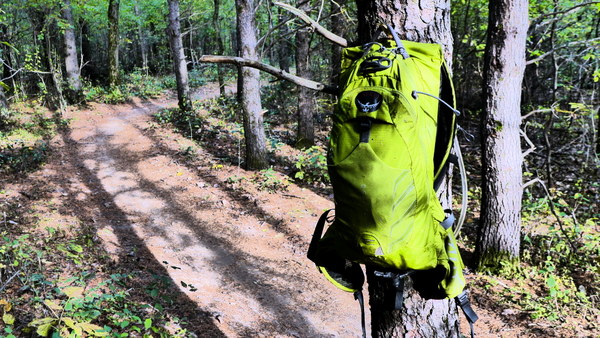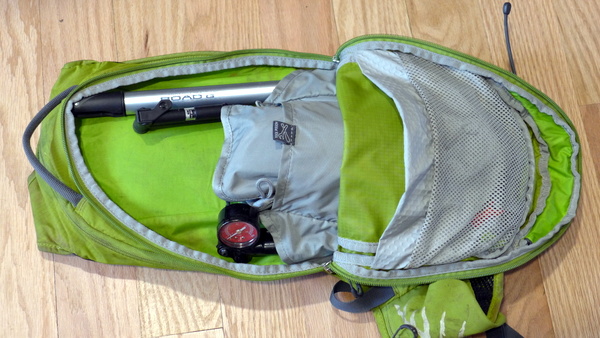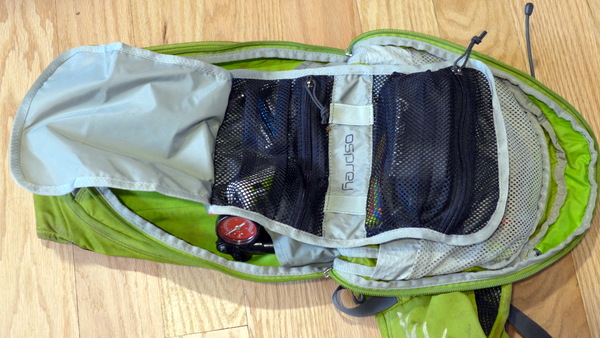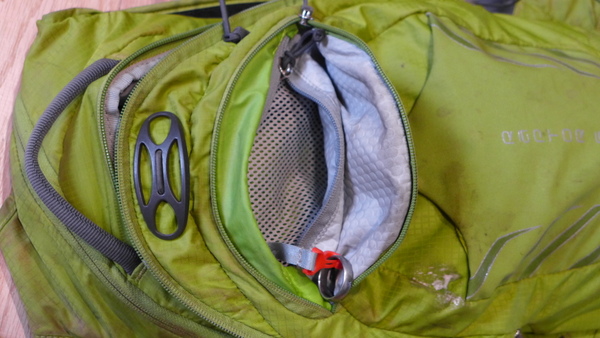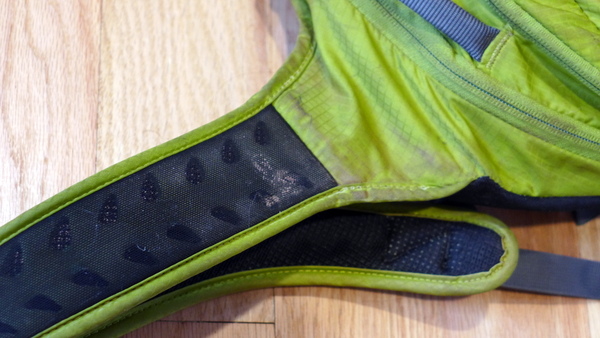Osprey has been making backpacking packs since 1974, and have built a reputation for themselves as one of the most durable pack makers. In 2009, they introduced the Hydraulics line, aimed at cyclists and runners, these are smaller packs that have specific designs and integrated hydration bladders. The Raptor series is for mountain biking, trail running and light hiking, and were re-designed in 2012 with easier bladder removal, a tool pouch, lighter shoulder straps and better ventilation than the first generation.
I have used this pack as my go-to for day rides for the last two years, trying to get to the edge on that legendary Osprey durability. It has been crashed, submerged, rained on and sweated in. Here’s how it held up…
The “6” in the name of the Raptor 6 refers to the volume of the pack in liters, with it being the smallest of the Raptor line. A 10 and 14 are also available. I found the 6 to be just the right size for day rides, as the space inside was very thoughtfully sorted out to carry all of the things necessary. There is an included roll-up tool pouch for the small things, along with two slots on each side of the pouch for pumps or other longer things. I typically carried a tire pump, shock pump, multi-tool, tire lever, chain lube, spare tube, cell phone, keys and camera on a ride. There was plenty of room for all of these things, as well as extra for any additional food or clothing needed that day.
The front zipper moves around the pack 180 degrees, allowing for a full view of what is inside the pack when fully open. Dual zippers also allow you to place them anywhere along this path when closed, and Osprey calls this Direct Access Zip. With everything in its place, the pack is tidy and organized, making it much easier to find things when you need them. The side slots are generous for the pumps, with enough space for the abnormally long Topeak Road Morph that I typically use.
With the tool pouch pulled out and unrolled, everything is in a nice, easy to access spot.
Direct Access Zip also refers to how you remove the bladder from the pack. Instead of hidden ports and small straps, Osprey uses a single zipper that starts on the right shoulder, and goes up, across the pack, and down the left side. Simply unzipping this completely frees the bladder from the pack, making removal of the bladder extremely simple. This is really important, since you are either fighting to remove the hose, or trying to fill the bladder while still in the pack on other designs. I find this single zipper to be the most thought out feature of the pack, and it’s pretty much the reason I always grab this pack first when going for a day ride.
On the front of the pack are two small zippered compartments for items you need to carry along such as keys, phone and wallet. One pocket is inside the other, and inside the smaller one is a nice little clip, intended for keys. Since I take my wedding ring off to ride, I found it perfect for making sure my ring doesn’t go missing if I am searching through the pocket. The pocket is also large enough to hold a wallet and large smartphone. The Raptor also has the LidLock helmet retention system on it like most other Osprey packs, although I didn’t use it on this pack, since this pack is made for riding.
The waist belt also has two zippered pockets. They are well constructed, but pretty small, as they would not fit a point-and-shoot camera with a lens such as the Lumix LX7, but did fit subcompact cameras like the Canon S95, and are probably intended for a small multi-tool.
Being well-known for durability, but moving into making lightweight packs from thinner materials, Osprey had to make sure these packs would hold their reputation. A lightweight shoulder strap is typically the first part of any heavily used pack to wear out, thanks to the use of softer materials in a high abrasion area. While using the Raptor 6, I took a high-speed over-the-bars spill, with the impact going right into my shoulder, and ripping up my skin and a standard jersey. In this area, Osprey makes the shoulder strap out of a fine mesh, die-cut foam and rip-stop nylon. After two years of solid use, and a slide down the trail, I was really impressed that the pack was still intact, but above that, even the seam still had full stitching, with no fabric or threads damaged. The only thing showing from this crash that taco’d a front wheel was a bit of dirt on the fabric. Impressive. My only gripe is that the bright color tends to pick up and show dirt pretty fast, in the pictures you can see that the inside of the pack is much brighter than the outside.
The Osprey Raptor 6 sells for $109.95. If a simple, organized and durable pack sounds good to do, put this one at the top of your list.
